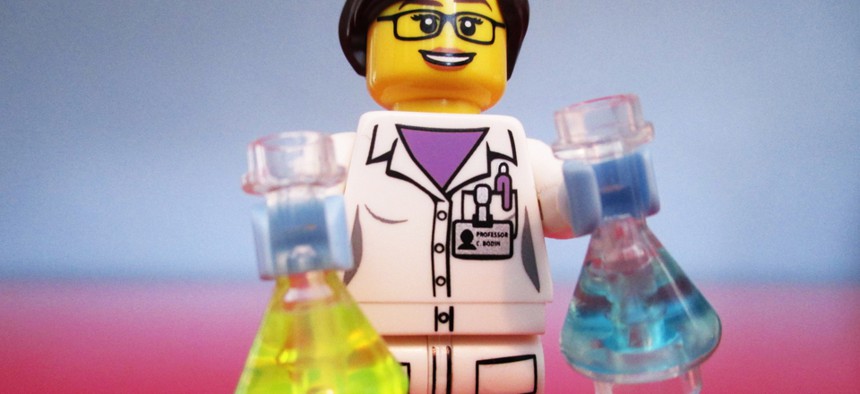
Flickr user pixbymaia
Lego’s Female Scientist Set Could Inspire a Generation of Girls
Encouraging women to work in STEM fields would be a big help to dwindling American STEM workers.
Even in Legoland, men have long dominated science . That’s about to change, though. The Danish company just launched Lego Research Institute, a $19.99 line featuring a paleontologist, astronomer and a chemist . Behold:

This trio of one-inch female scientists was created by Ellen Kooijman, a “real-life geoscientist,” and selected by vote among LEGO Ideas members. It was so popular, it beat out a set based on Sherlock . This is a big deal for “girl power,” as a male commenter from Canada noted.
The implications could be even bigger for the US and other economies. America desperately needs more workers in science, technology, engineering and math (STEM). Part of the problem is that only 26% of STEM workers are women (pdf, p.5), despite the fact that they make up half of the overall workforce.
Clearly, encouraging women to work in STEM fields would be a big help. One huge hurdle, however, is keeping girls interested. Research shows that in kindergarten, boys and girls were equally interested in science (paywall); by the end of high school, though, the gap in interests rose twenty-fold.
What happens to derail that interest? Toys, for one thing. Not only do they spur cognitive and social development (pdf, p.632), they also shape children’s sense of gender.
An example of how that happens: In a 2014 study of girls between the ages of four and seven, those who played with a Barbie doll—even Doctor Barbie—said that fewer occupations were open (paywall) to them, compared with boys. The girls who played with Mrs. Potato Head, on the other hand, identified nearly as many future career options available to themselves as boys.
That doesn’t mean that playing with male figurines affects girls’ career planning. But even in the relatively progressive world of Legoland, girls haven’t had much of a choice, as Scientific American notes :

Not only does Lego’s new line of female scientists invite girls to consider pursuing STEM subjects; it presents a reality in which they already are STEM workers. That validation may help build girls’ confidence in their abilities early on if it solidifies the notion that many women excel in math and science. Research has found that attitudes of boys being better at math heavily discourages girls’ interest in math and self-confidence in their abilities—especially among higher-achieving girls.
Shaping boys’ attitudes toward professional women helps. Good thing Lego Research Lab isn’t explicitly marketed toward girls. Neither is Lego’s “Scientist ,” who was released in Sept. 2013 in a bundle with other minifigures, named “Female Scientist.”

Then again, that Lego pack included “Pretzel Girl,” “Diner Waitress,” and “Grandma” (compared with male characters like “Constable,” “Mountain Climber,” and “Welder”).
Other companies that have tried their hand at girls’ STEM-themed figurines veer even more toward the ultra-feminine. Here’s Mattel’s computer software engineer Barbie from 2010:

In real life, at least, over-feminizing science can do more harm than good. One recent study found that, because they seemed “particularly unattainable,” super-feminine STEM role models
actually deter middle-school girls
(pdf) from studying math and science.
Of course, kids should play with pink-frilled princesses and Barbie Dream Houses if they want to. But they should have options that run a broader gamut of what “females” look like. Even among Legos, “female” minifigures tend to wear things like seashells, bodices, and a lot of pink, as you can see below. Thanks to the trio of Lego Research Lab, girls and boys can now find at least a few “female” Legos dressed to offer the world more than an hourglass shape.
( Top image via Flickr user pixbymaia )






